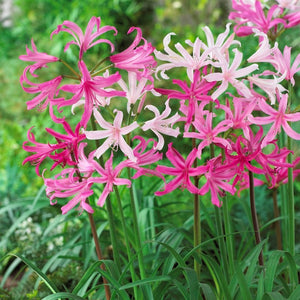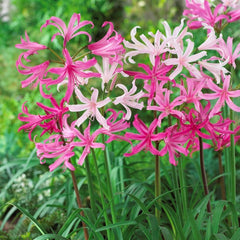Nerine Planting & Growing Guide
While spring is widely regarded as the season of flowers, fall is far too often forgotten when it comes to blooming beauty. However, as most plants slip into dormancy, Nerines are just getting the show started with long-lasting, showy blossoms in pink, red, and white shades. During the late spring and summer months, these showstoppers produce clusters of strappy, glossy green foliage, with flower stalks growing up to 2' tall in the autumn. Care to know more about these exquisite plants? Here's everything you need to know.
Success Snapshot
PLANTING
DEPTH
Top just below soil line

WATER
QUANTITY
Moderate
SUNLIGHT
QUANTITY
Partial Sun to Partial Shade
PLANTING
PROXIMITY
8-10" Apart
BLOOM
SEASON
Late Summer to Fall
HARDINESS
ZONES
Zones 9-11
Shop Related Products
Where to Plant
Plant Nerine bulbs in a location where the soil drains well. In warmer regions, site them where they will receive morning sun and afternoon shade. In cooler climates, full sun will produce the best results. If you notice puddles of water 5–6 hours after a hard rain, scout out another site or amend the soil with organic material to raise the level 2–3 inches. These plants are great for containers or outdoor plantings but will not thrive in soggy soil or standing water.
When to Plant
Plant your Nerine bulbs in the spring after the danger of frost has passed. The plants will quickly produce strappy foliage that gathers sunlight and strengthens the plants during the spring and early summer months, with flower stalks emerging in the fall.
How to Plant
- For outdoor landscape planting, find a spot where the soil drains well and your Nerine plants will receive plenty of sun. Dig holes 8 to 10" apart and plant with the necks and roughly 1" of the bulbs above the soil surface.
- For container planting, start with good quality, well-drained potting soil and a container with adequate drainage holes. Dig holes 8 to 10" apart and plant with the necks and roughly 1" of the bulbs above the soil surface.
- Water thoroughly after planting, soaking the soil to settle it around the bulbs.
How to Grow
- Water generously during active growth periods and very little when the plants are dormant.
- Cut off spent flower stalks after blooming has finished for the season.
- Allow your Nerine plants to rest for a few months in dormancy before beginning the next growing cycle in the spring.
- Pull up the bulbs if you're gardening in a zone where they are not winter hardy. Clean off excess soil, air dry for one or two days, and store in a cool, dry place in peat moss. Replant the bulbs in the spring after the danger of frost has passed.
Nerine Tips & Tricks
- Feel free to snip stems when in bloom for bouquets, as doing so will not hurt your plants, and the cut flowers are super long-lasting.
- Inspect the bulbs to locate the top part of the bulb, which looks a little like the stem area of an onion.
- Consider pairing your Nerines with Eucomis Tugela Jade, Ismene, or other annual plants that appreciate half-day sun in a container.
- Don't worry if the soil is coarse or even a bit gritty, as Nerines are only fussy in waterlogged or moist soil.
- Amend the soil with ground bark, decomposed manure, or compost to improve drainage and encourage a healthy start.
- Bear in mind that these plants enjoy being crowded, so don't worry about dividing them unless flower production decreases. Dig up clumps in spring or early summer and split them apart to be moved or shared as needed.


